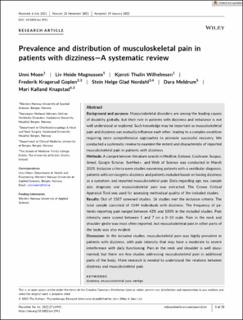| dc.contributor.author | Moen, Unni | |
| dc.contributor.author | Magnussen, Liv Heide | |
| dc.contributor.author | Wilhelmsen, Kjersti Thulin | |
| dc.contributor.author | Goplen, Frederik Kragerud | |
| dc.contributor.author | Nordahl, Stein Helge Glad | |
| dc.contributor.author | Meldrum, Dara | |
| dc.contributor.author | Knapstad, Mari Kalland | |
| dc.date.accessioned | 2022-07-01T11:49:02Z | |
| dc.date.available | 2022-07-01T11:49:02Z | |
| dc.date.created | 2022-05-19T14:28:15Z | |
| dc.date.issued | 2022 | |
| dc.identifier.issn | 1358-2267 | |
| dc.identifier.uri | https://hdl.handle.net/11250/3002064 | |
| dc.description.abstract | Background and purpose
Musculoskeletal disorders are among the leading causes of disability globally, but their role in patients with dizziness and imbalance is not well understood or explored. Such knowledge may be important as musculoskeletal pain and dizziness can mutually influence each other, leading to a complex condition requiring more comprehensive approaches to promote successful recovery. We conducted a systematic review to examine the extent and characteristic of reported musculoskeletal pain in patients with dizziness.
Methods
A comprehensive literature search in Medline, Embase, Cochrane, Scopus, Amed, Google Scholar, SveMed+, and Web of Science was conducted in March 2021. Inclusion criteria were studies examining patients with a vestibular diagnosis, patients with cervicogenic dizziness and patients included based on having dizziness as a symptom; and reported musculoskeletal pain. Data regarding age, sex, sample size, diagnosis and musculoskeletal pain was extracted. The Crowe Critical Appraisal Tool was used for assessing methodical quality of the included studies.
Results
Out of 1507 screened studies, 16 studies met the inclusion criteria. The total sample consisted of 1144 individuals with dizziness. The frequency of patients reporting pain ranged between 43% and 100% in the included studies. Pain intensity were scored between 5 and 7 on a 0–10 scale. Pain in the neck and shoulder girdle was most often reported, but musculoskeletal pain in other parts of the body was also evident.
Discussion
In the included studies, musculoskeletal pain was highly prevalent in patients with dizziness, with pain intensity that may have a moderate to severe interference with daily functioning. Pain in the neck and shoulder is well documented, but there are few studies addressing musculoskeletal pain in additional parts of the body. More research is needed to understand the relations between dizziness and musculoskeletal pain. | en_US |
| dc.language.iso | eng | en_US |
| dc.publisher | Wiley | en_US |
| dc.rights | Navngivelse 4.0 Internasjonal | * |
| dc.rights.uri | http://creativecommons.org/licenses/by/4.0/deed.no | * |
| dc.title | Prevalence and distribution of musculoskeletal pain in patients with dizziness—A systematic review | en_US |
| dc.type | Journal article | en_US |
| dc.type | Peer reviewed | en_US |
| dc.description.version | publishedVersion | en_US |
| dc.rights.holder | Copyright 2022 The Authors | en_US |
| dc.source.articlenumber | e1941 | en_US |
| cristin.ispublished | true | |
| cristin.fulltext | original | |
| cristin.qualitycode | 1 | |
| dc.identifier.doi | 10.1002/pri.1941 | |
| dc.identifier.cristin | 2025712 | |
| dc.source.journal | Physiotherapy Research International | en_US |
| dc.identifier.citation | Physiotherapy Research International. 2022, 27 (2), e1941. | en_US |
| dc.source.volume | 27 | en_US |
| dc.source.issue | 2 | en_US |

